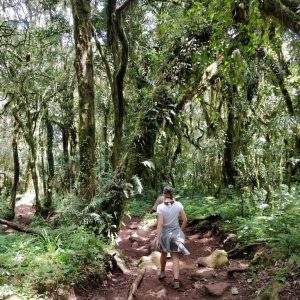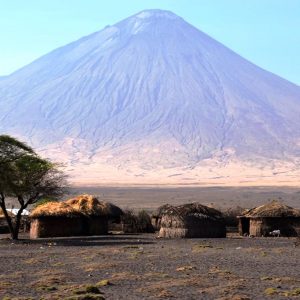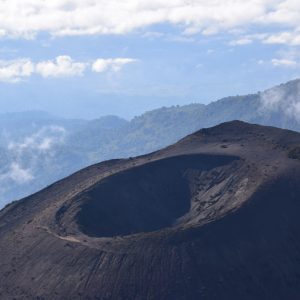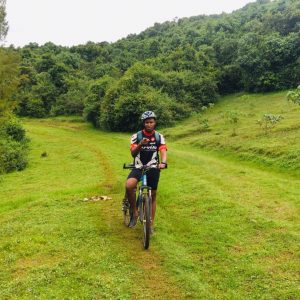7 Days Kilimanjaro Machame Route (6 days possible)
- A popular route on Kilimanjaro, known as the Whiskey Route
- Belongs to the most attractive ascent routes because of the scenic landscape
- Different routes for ascent and descent
- Conditionally demanding with constant alternating ascents and descents for a good acclimatization
Tour FAQs
- Overview
- Itinerary
- Circuit / Region
- Included Services
- Excluded Services
- Options
- Rates
- Best Time To Travel
- Packing Tips
- Notes
Machame Route approaches Kilimanjaro from the south-west and is considered one of the most beautiful routes with incredible vegetation. Every day you walk through a different vegetation zone you cross rain-forest, run over ridges and through valleys and end up in the middle of the dry stone desert, the Shira Plateau, the highest plateau in the world. The last part of the hike on to Uhuru Peak leads through an arctic climate zone. The route is also suitable for a better acclimatization to the altitude. If you choose the Machame Route, you have a very good chance of reaching the summit of Kilimanjaro. However, it should be said in advance that the Machame Route is also one of the most popular routes and is therefore often crowded.
Because the trail is considered difficult, steep and challenging, this route requires good physical condition, as well as hiking or backpacking experience. The tour can be done in 6 or 7 days, whereby the 7 day route offers a maximum time for acclimatization.
Short Overview
Day 1: Machame Gate to Machame Camp
(1.634 m/5,380 ft to 3.010 m/9,875 ft)
Duration: 5 - 7 h
Day 2: Machame Camp to Shira Camp
(3.010 m/9,875 ft to 3.840 m/12,598 ft)
Duration: 4 - 6 h
Day 3: Shira Camp via Lava Tower to Barranco Camp
(3.840 m/12,598 ft to 4.600 m/15,190 ft to 3.960 m/ 12,992 ft)
Duration: 6 - 8 h
Day 4: Barranco Camp to Karanga Camp
(3.900 m/13,044 ft to 4.030 m/13,221 ft)
Duration: 3 - 4 h
Day 5: Karanga Camp to Barafu Camp
(4.030 m/13,221 ft to 4.600 m/15,331 ft)
Duration: 3 - 4 h
Day 6: Barafu Camp to Uhuru Peak to Mweka Camp
(4.600m/15,331 ft to 5.895 m/19,341 ft to 3.100 m/10,065 ft)
Duration 10 - 15 h
Day 7: Mweka Forest Camp to Mweka Gate
(3.100 m/10,065 ft to 1.630 m/5,347 ft)
Duration: 3 - 4 h
Detailed Itinarary
- Day 1: Machame Gate to Machame Camp
After breakfast you will be picked up from the hotel. You drive with the mountain guide to the National Park gate in Machame, where your Kilimanjaro trekking tour starts. The drive takes 30 to 40 minutes. After hiking on a wide forest road for about an hour, the real trail begins, which leads through dense tropical mountain rainforest. After about half of the stage, the trail gradually becomes steeper and more strenuous. You leave the mountain rain forest at an altitude of 2.700 m (8,858 ft) and the heath landscape begins. After a 5 to 7 hours hike you reach Machame Camp for dinner and overnight. - Day 2: Machame Camp to Shira Camp
After an early breakfast you start the ascend to Shira Camp which takes 4 to 6 hours. From Machame Camp at approx. 3.010 m (9,875 ft) it goes up to Shira Camp (3.840 m / 12,598 ft). It is a steep ascent which leads you today from the heather landscape to an open moorland. Just before the next camp you reach the Shira plateau. If sky is clear you have a breathtaking view of mount Meru, Kibo peak and to the village down the mountain. Dinner and overnight at Shira Camp. - Day 3: Shira Camp via Lava Tower to Barranco Camp
After breakfast you start hiking to the Barranco Camp, which lasts 6 to 8 hours. This day is important as it is an acclimatization walk. First you go to the Lava Tower, a mighty boulder (4.600 m / 15,091 ft), and then down to the Barranco Camp for dinner and overnight. In the descent to the Barranco Camp we pass the Barranco Valley, where giant lobelia and meter high Senecia grow and you will have impressive views of the Kibo glacier. - Day 4: Barranco Camp to Karanga Valley Camp
This will be a short day which takes 3 to 4 h, whereby soon after breakfast you begin with the ascend of the great Barranco Wall. The climb is often referred to as the "Breakfast Wall" as this is the first thing you need to do on the fourth day after breakfast. The height of the Barranco Wall is 257 meters /902 ft and the ascent will take between 1 and 2 hours depending on your fitness level. That route with its numerous ascents and descents allows further acclimatization before you reach the ridge. On a hike along the ridge you can enjoy the beautiful landscape with its breathtaking contrasts of desert and vegetation before you finally reach the cloudy Karanga Camp for hot lunch and overnight. - Day 5: Karanga Valley Camp to Barafu Camp
After breakfast start the ascend through the Alpine desert to Barafu camp. You will have hot lunch short break thereafter take some walk to at least 200 m (656 ft) higher. Dinner and overnight at Barafu Camp. - Day 6: Barafu Camp via Stella Point to the summit Uhuru Peak and descent via Mweka route to Mweka forest camp
After a cup of tea / coffee with a few bites, you start climbing the summit around midnight. Pole pole (slow) is highly recommended. The Stella Point at 5.730 m (18,799 ft) is the first stage that you can reach via frozen volcanic ash and scree. Towards sunrise, you are at the top of Uhuru Peak (5.895 m/19,341 ft). After a short break with summit celebrations, descend to Barafu Camp for lunch and a short break and then continue to Mweka Camp for dinner and overnight. - Day 7: Mweka Forest Camp to Mweka Gate / Moshi
After breakfast, start descending through the rainforest to the Mweka Gate. There you will find a waiting car that will take you back to your accommodation in Moshi.
- Transport from and to your hotel/residence or Airport/seaport
- Private English-speaking Professional mountain guides
- Guides, Porters, cook salaries
- All park fees
- Rescue fees
- All meals while on the mountain incl. filtered Water, tea & coffee
- Government taxes, VAT and All relating service charges
- First Aid Kit & summit Oxygen
- hot Water for washing
- Sleeping tent
- Mess tent
- Table and chairs
- Sleeping form mattress
- Emergency evacuation by Flying doctor
- International/national flights and visa fees
- Tips for guides and support staff
- Sleeping bag, mat and personal items for the hike (please have a look at our packing list). Almost all equipment is available to rent from our team in Tanzania if required.
- Bath towels
- Private portable toilet and privacy tent
- Personal expenses (airport taxes, Internet, soft and alcoholic drinks, snacks, laundry etc.)
- Government-imposed increase in taxes and/or park entrance fees
- Anything else not mentioned in the inclusions
- This route can be done in 6 days but it is advised to take an extra day for acclimatization
- On request other tour languages possible
- Additional accommodation before and after the tour can be arranged for an extra cost
- Extension of the tour or an additional program is possible or have a look at our other offers
- Between January and March the temperatures are mild, the weather in the morning and afternoon is nice and the visibility of the mountain is particularly good
- In June and July the sky is clear and the nights are cold
- August, September and October are the warmest months to Climb Kilimanjaro
- Rainy season: Late March to mid-May and November and December. there is snow in the higher elevations
Please follow the list below to ensure your comfort. You will have a better vacation if you are prepared.
But please note that this list is not exhaustive!
Almost all equipment is available to rent from our team in Tanzania if required. Please talk to us in advance for further planning.
The climb to the summit of Kilimanjaro leads through four climatic zones. Therefore, the weather can range from warm and tropical at the base of the mountain to freezing on the summit and the temperatures can range from + 20 ° C down to -15 ° C.
Cotton should be avoided as it is hydrophilic, which means it absorbs moisture and blocks breathability.
Since June 1, 2019, Tanzania has been banned from using single-use plastic bags. If you want to separate items in your bag, please use re-usable "packing cubes". Please also note that disposable plastic bottles are not permitted on Kilimanjaro.
Please note that your large backpack can weigh a maximum of 20 kg. This is the maximum permissible weight that a porter can carry. This weight limit is checked at the hotel pickup.
To carry your most important belongings with you, a 20 - 40 l daypack is best. You should pack your backpack very carefully and not carry too much with you, because at altitude you need all the strength for your ascent.
Basic Equipment
- Daypack 30 – 40 L (for your personal belongings, you need to carry it yourself) + rain cover
- Duffle bag or backpack (60 – 80 L / maximum weight 20 kg/carried by the porter) + rain cover
- Sleeping bag (possible to hire from our team in Tanzania)
- 1x mat/sleeping pad – to protect from hard and cold underground (possible to hire from our team in Tanzania)
- Trekking poles
- Water bladder/bottles for 3 liters of water (please remember disposable plastic bottles are not permitted)
CLOTHES
Head
- Warm hat
- Sun hat
- Scarf
- Sunglasses with high UV protection
- Headlamp (for summit night and toilet) with extra batteries
Hands & Feet
- 1 x light gloves
- 1 x winter gloves (summit day)
- Waterproof Hiking boots (they should fit well, with lots of room for the toes, and are well worn in before starting the trek)
- Training shoes (for the camp)
- Outer socks, liner socks and one pair of thermal socks for summit day
- Gaiters (protection against the ingress of rubble and moisture / not particularly necessary)
- Micro-spikes (possible to hire from our team in Tanzania)
Upper body and legs
- Fleece or softshell jacket
- Hard shell outer jacket (for protection against rain and wind)
- Poncho (recommended if climbing during raining season April/May and November
- Fleece pullover
- Long and short sleeve hiking shirts
- Functional sports underwear
- Thermal or fleece leggings
- Light or medium trekking pants
- Hard shell pants (waterproof/windproof)
POSSIBLE CONTENT of a PHARMACEUTICAL TRAVEL KIT
- Plasters & blister plasters, tapes, bands, cotton, alcohol
- Medicine against diarrhea, nausea, headache, stomachache, altitude sickness, Malaria
- Painkillers
- Personal medication
- Nasal spray
- Antiseptic ointment
- Electrolytes (to avoid dehydration in case of high fluid loss)
- Contact lenses cleaner
- Insect repellent
MISCELLANEOUS
- Sunscreen with High SPF and lip protection balm
- Packing cubes (for organizing the items in the duffle bag)
- Personal snacks (e. g. cereal & energy bars, nuts, isotonic drink powder, chewable vitamin tablets with dextrose)
- Ear plugs
- Toilet bag for personal belongings like toothbrush, toothpaste, soap, wet wipes and hand sanitizer
- Towel
- Camera and spare batteries
- The two different seasons that represent the best time to climb Kilimanjaro are January - March and June - October.
Are you ready to explore Africa?
This itinerary is an example of tours we organize.
Contact us by email, WhatsApp or phone to create your individual trip or choose one of our itineraries without obligation!
-book now-














